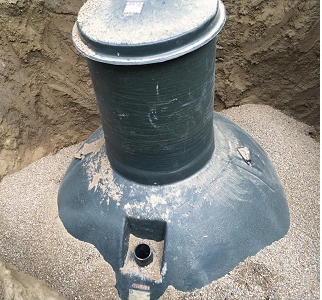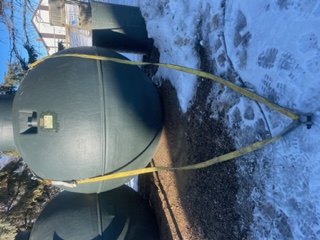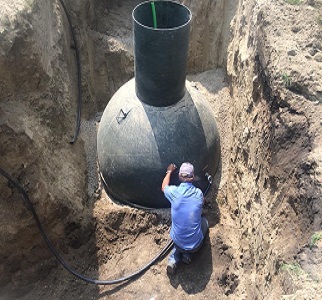
Welcome to Septic-Tanks.ca of Saskatchewan & Manitoba
SEPTIC TANK INSTALLATION PROCEDURE
When I’m installing a fiberglass septic tank I locate the pipe under the footing and dig straight down being careful not to hit the foundation or the pipe and looking for that blue cap. We are going to install the septictank about 15-20 feet away from the house with the home owner’s permission. At this point it’s all about safety and quality! The trench will be about 6 feet deep leading up to the septic tank so slope the edges back so it doesn’t cave in while you’re on your knees connecting the ABS sewer pipe. At this point we have dug about 10-12 feet away from the house, in that distance the grade has only dropped about 1 inch. This trench must be perfectly graded so the ABS pipe sits on hard packed original ground. It doesn’t have to sit on sand….as long as there are no sharp rocks under the pipe.
I begin digging out an area 7 feet by7 feet, this excavation is for a 750 gallon size tank and we want about 6 inches of free space all the way around the tank. When I’m digging, I save the best dirt for backfill by piling it close and about 4 feet away from the excavation. I have dug down to the level of our trench and I do not disturb the trench. This is just an example but let’s dig down 10 feet deep measuring from the high ground. This is the time where I hook the 10 foot slings to the fiberglass septic tank and pick it up with the excavator. All I’m doing is making sure the septic tank fits nicely in the hole and the inlet of the tank is lower than the pipe coming from the house. If all is good I remove the septic tank and put it back where it was and unhook the slings from the excavator.



Now…..at some point we had about 12 yards of sand delivered and dumped within reach of the excavator. Making sure the bottom of the hole is flat and free of stones I pick about a wheel barrow size bucket of sand up and place it in the bottom of the hole. The fiberglass septic tank will sit on the sand to protect it from a sharp rock, about 6 inches is good. You only need to put sand in the middle, about a 3 foot circle or square. Once the sand is level I pick the tank up again and rest it on the sand. I’m very fussy so my septic tank sits perfectly level and plumb. I check it with a 2 foot level and if all is good I backfill the tank with the rest of the sand. Dump the sand evenly all the way around the septic tank being careful not to move the tank.
On the back side of the septic tank there is a 1-1/4 inch bulkhead and that is where we connect the poly pipe that takes the liquid away from the tank to the ejector. I will talk about that on another page. The poly pipe must be connected before the septic tank is completely backfilled! Click here to learn about installing the ejector.
When you placed the septic tank in the hole it sits as close as possible to the 4 inch sewer pipe coming from the house. From the end of the trench to the inlet of the septic tank there is an open hole that was filled with sand…..make sure to pack that sand well so it doesn’t settle under the sewer pipe. We will lay the pipe and make the connections…dry and clean all the fittings and use ABS glue, it is yellow. When the two pieces make contact you have about 5 seconds and the glue is hard and not coming apart. So make sure the pipe is running down hill and connected properly.
Our fiberglass tanks come with a 3 foot extension and we add a 3 foot extension. I apply caulking to the joint and install the 3 foot extension to the top. I also install 5 self-tapping screws to hold the extension in place. Install the extension when the ball part of the septic tank is covered. Make sure the round part of the fiberglass septic tank has sand on it then backfill with clay. The top of the extension should be at least 6 inches above ground. There is a pump in the tank that needs electricity so we always place underground wire next to the pipe and up the side of the extension fastened to a 4 X 4 pressure treated post. The post should be about 2 feet above ground and that is where an electrician will mount a receptacle box to plug the pump into. We usually push the other end under the footing to the inside of the basement and the electrician will get power to it.